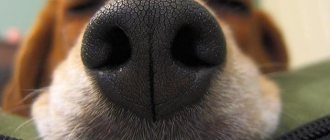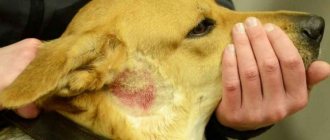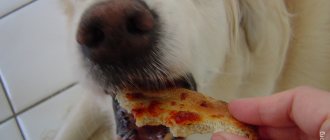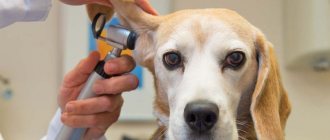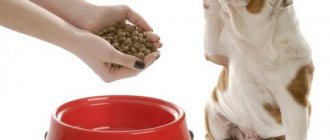There are about 300 types of bacteria in every dog's mouth. Mixing with saliva, they form a thin film that envelops the surface of the teeth. If you don't brush your pet's teeth, the film becomes denser and then turns into plaque.
This is gingivitis, which in 9 out of 10 cases is accompanied by an unpleasant odor from the mouth (halitosis). What signs indicate the development of gingivitis? Is it possible to cope with it at home? Experienced veterinarians talk about everything in more detail.
Read in this article
The main causes of gingivitis Signs indicating gum inflammation Types of gingivitis What to do if your dog has gingivitis? Diagnosis of the disease How to treat gingivitis in dogs? Treatment of gingivitis at home Nutrition of a dog with gingivitis Prevention of the disease
Main causes of gingivitis
Gingivitis is inflammation of the gums. It almost always develops with poor oral hygiene or its complete absence. If you don't brush your dog's teeth every day, tartar will inevitably form, which in later stages provokes the development of gingivitis.
Less common causes of gum inflammation in animals are:
- hormonal imbalances,
- autoimmune pathologies,
- genetic predisposition,
- caries,
- mechanical damage to the gums (for example, fragments of tubular bones),
- other diseases (diabetes mellitus, liver and kidney diseases).
Another common cause of gingivitis in dogs is an unbalanced diet. The lack of complete amino acids, minerals, as well as vitamins A, C and group B negatively affects the condition of the mucous membranes of the oral cavity and leads to inflammatory processes.
Some viral diseases can affect the oral mucosa of cats. For example, calicivirus is characterized by the appearance of ulcers on the surface of the tongue; immunodeficiency and leukemia viruses can cause gingivitis (gum inflammation). The gums are reddened, easily injured and bleed. Treatment in these cases is carried out based on the underlying disease and condition of the patient. Treatment of the oral cavity with antiseptics is also indicated.
Odontoclastic resorptive lesions of teeth cause destruction of tooth roots, leading to gum inflammation, infection, pain, and bad breath. The crown part of the tooth may break due to such damage. A visit to the veterinary dentist for this pathology is necessary. The correct solution is to remove the affected teeth, or only their crown parts during root resorption.
Signs indicating gum inflammation
Gingivitis in dogs develops gradually, so the symptoms are increasing. The first thing that pets encounter is partial redness and swelling of the gums. This condition is accompanied by general weakness and refusal to eat.
Signs of gingivitis in dogs:
- redness and swelling of the gums,
- bleeding (especially during meals),
- unpleasant odor from the mouth,
- profuse salivation,
- small ulcers in the mouth,
- cyanosis of interdental spaces,
- loose teeth,
- burning and pain in the affected areas.
The dog refuses to play and whines in pain (for example, when chewing food). In the later stages of gingivitis, when general health deteriorates greatly, the animal refuses to walk, lies most of the time, and loses weight.
Oral diseases in dogs
The main symptoms of oral diseases in dogs are refusal to eat food or pain when chewing or swallowing it, unpleasant odor from the mouth, drooling, tremors of the masticatory muscles, fistulas under the eyes, and enlarged submandibular lymph nodes.
The etiological factors for the development of oral diseases in dogs are diseases of the immune and endocrine systems, hormonal dysfunctions, congenital pathologies of the oral cavity, abnormal bite, and so on. Often the cause of oral diseases is the presence of plaque and stone.
The most common diseases in this group are:
Stomatitis is an inflammation of the oral mucosa. The most characteristic signs of stomatitis are painful eating, drooling, and an unpleasant odor from the mouth. The oral mucosa is hyperemic and edematous.
First aid consists of irrigating the oral cavity with a warm 2% solution of table salt, a pale pink solution of potassium permanganate, a 2% solution of protargol, and a 2% solution of baking soda. Among medicinal herbs, decoctions of sage, chamomile, and oak bark give a good effect. You can also treat the oral cavity with Lugol's solution.
Forms: catarrhal, papillomatous, ulcerative.
Gingivitis is an inflammation of the gums caused by the adverse effects of local and general factors and occurring without compromising the integrity of the dentogingival junction.
With gingivitis, the gums become bright red and swollen. Eating is difficult. Drooling may occur. Gums are bleeding.
Forms: catarrhal, ulcerative, hypertrophic.
Periodontitis is an inflammation of periodontal tissues (tissues surrounding the tooth), characterized by progressive destruction (destruction) of the periodontium and alveolar bone (tooth socket - the depression in the jaw in which the root of the tooth is located) of the jaw process. The symptoms are similar to those of gingivitis. When examining the oral cavity, pockets of the periodontal zone are found, the teeth are mobile and painful. Loss of teeth is also possible.
Treatment of periodontal diseases should be comprehensive, taking into account the etiology, pathogenesis, clinical course of the disease, and be carried out by a veterinary specialist in a clinical setting.
Forms: localized, generalized.
Periodontal disease is a dystrophic (pathological condition of tissues characterized by metabolic disorders and structural changes) damage to the periodontium.
The disease is characterized by a chronic course.
As a rule, periodontal disease is a pathological syndrome of common somatic diseases.
As the process develops, pallor of the gums, multiple exposure of tooth roots, the appearance of diastemas (increasing the gap between teeth), and fan-shaped divergence of teeth are observed.
At later stages, pathological mobility of teeth occurs.
Treatment is prescribed only by a specialist after a thorough examination of the oral cavity.
To prevent oral diseases, you need to regularly examine your pet’s oral cavity, clean plaque twice a week with special pastes for animals, remove tartar as necessary using instruments or an ultrasonic scaler, and regularly immunize dogs and cats. All this will help prevent oral diseases in your pet.
Tartar in dogs
Teeth play a huge role in the life of any mammal, including dogs. In addition, all stomach problems are usually caused by pathogenic processes in the mouth...
Further
Plaque and tartar in dogs
Dental plaque is a biofilm found throughout the oral cavity. There are supragingival and subgingival (direct contact with the gum). Dental plaque consists of mucus...
Further
Caries in dogs
Caries is a lesion of the hard tissues of the tooth, which causes the destruction of enamel and dentin. As this disease progresses, it leads to the formation of cavities in the tooth and in some…
Further
Malocclusion in dogs
Most people believe that animals, and especially dogs, simply cannot have any problems with their teeth. This is a big misconception. Dogs, although less common than people...
Further
Periodontal disease in dogs
Periodontal disease is one of the most common oral diseases not only in humans, but also in dogs. In fact, almost every third pet suffers from a lesion...
Further
Stomatitis in dogs
Stomatitis is a fairly common disease in dogs.
It is characterized by inflammation of the oral mucosa, which usually resolves... More
Types of gingivitis
By type of manifestation:
Spicy. Its main feature is its vivid clinical picture. All symptoms of gingivitis (redness, swelling, bleeding) appear quickly. The pet's condition is rapidly deteriorating.
Chronic. Symptoms develop gradually. Improvements are observed periodically (for example, swelling of the gums goes away) and relapses. Chronic gingivitis is more dangerous because it is difficult to diagnose in the early stages.
By degree of distribution:
Localized . Inflammation of the gums and other accompanying symptoms appear pointwise (locally) and cover not the entire oral cavity, but a certain area. In this case, the pet tries to chew food in the area where there is no gingivitis.
Generalized . The inflammatory process covers all soft tissues. This makes it possible to quickly diagnose gingivitis, but at the same time significantly complicates its treatment, since the symptoms are extensive.
The nature:
Catarrhal (serous ). This is the most common type of gingivitis and develops under the influence of external factors (for example, bacteria or allergens). Usually localized throughout the oral cavity.
Hypertrophic . Occurs due to internal factors (for example, hormonal imbalances or diseases of the gastrointestinal tract). In this case, hypertrophic gingivitis is localized on the incisors, molars and canines.
Prevention of stomatitis
The main preventive measure is the organization of normal living conditions for the dog, proper nutrition (control of food temperature and the presence in food of anything that can injure the mucous membrane) and timely deworming and vaccination. All this reduces the risk of developing both primary and secondary stomatitis.
A radiator, a food and water conveyor, a wound healer, a taste recorder, a sensor and a wet version of the greeting handshake. The tongue has so many functions and responsibilities that no other part of the body has, with the exception of the brain, of course. Surprisingly, despite being so busy, this part of the body does not require special care at all.
Recently, my hunter friends invited me to photograph with my camera what they do with their dogs. I used up 4 rolls of film photographing the extraordinary training of three black Labradors. When I started developing the photographs, I was amazed at how many frames there were in which the objects of my photo hunt were captured with their long tongues sticking out and fluttering in the wind (I mean dogs, not their owners). In almost every photograph, the dogs' mouths were gaping so that the oncoming wind could easily enter their mouths, and their tongues were stuck out as far as possible. Seeing the photos made me think. Amazingly, in all my extensive veterinary practice, I have encountered only a couple of cases of tongue damage. But despite the fact that he is almost always outside the mouth, and sometimes flutters like a flag, injuries should happen all the time. However, in my 25 years as a veterinarian, I have very rarely seen injured tongues. Although quite often hunters call me and ask me in a panic to come quickly, because the dog “is just gushing blood from his mouth.” And when I rush as fast as I can to the “wounded” dog, mentally preparing for some unimaginably complex surgical operation, instead of a terrible wound, I find only a couple of lingering scratches. And the owner apologetically reports that “the blood stopped on its own.” Why is this happening?
We recommend reading: Nickname Jagdterrier
The thing is that at the moment of injury, which can be inflicted by a thorn, its own teeth, barbed wire or any other sharp object, the dog’s tongue is enlarged and filled with blood. During physical activity, such as running, the blood vessels in the tongue dilate, causing it to swell and fill with blood. And even a small injury at such a moment will cause streams of blood, and with a deep cut, the blood can even flow like a fountain. When the owner notices that the dog is literally bleeding, the hunt naturally stops immediately. And when the dog “cools down” and calms down, the blood flow decreases, that is, it returns to normal again. The tongue shrinks and in this state heals very quickly. So if your four-legged friend pierced his tongue somewhere in a field or swamp in the midst of a hunt, do not panic and do not call a rescue helicopter. Just stop, let your dog rest and take a couple of sips (no more!) of cold water. And if after this the blood still flows like a river, then you will still have to go to the vet.
When giving your dog water to cool his tongue, do not let him drink too much. The movements the tongue makes when lapping will interfere with the blood clotting and healing process. In addition, if the wound turns out to be serious (pah-pah) and the dog needs stitches, it is better that its stomach is empty. The anesthesia may cause vomiting, and the unconscious dog may choke.
The examination is carried out in daylight or any other good lighting, with the jaws opened comfortably. The procedure begins with examining the gums, simply by gently lifting or lowering the lips. The animal can be in any position that is comfortable for the person conducting the inspection.
Today I would like to talk about dog language. This muscular organ, located in the animal’s mouth, plays a very significant role in the life of our pets. Unfortunately, this is very often forgotten, but in vain. Often the condition of the tongue is a real “mirror of the health” of your pet. By its condition one can safely judge the condition of the animal’s entire body. For example, a white tongue in a dog may indicate pathologies of the digestive system and more.
A dog's tongue is a long, muscular organ connected to the jaw by the hyoid bone.
The top of the tongue is covered with five types of tiny receptors responsible for recognizing the taste of food (the principles of their operation, by the way, are still not fully understood). The thickness of this organ contains a huge number of blood vessels, and therefore serious damage to it is fraught with rapid death from massive bleeding. In general, the tongue is a very important component of the oral cavity.
Why was it created by nature? Its main task is to help the animal push food and liquid into the esophagus, as well as recognize the organoleptic properties of food. A dog's tongue can detect salty, sweet and sour tastes. The tip of a dog's tongue is spoon-like in shape. Thus, it greatly helps your pet in drinking any liquid. But this “muscle” in the dog’s body also has another, no less important, function.
As you know, there are very few sweat glands in the thickness of dog skin. Therefore, on a hot summer day, your pet may experience serious problems with overheating. The tongue is the only way of normal thermoregulation.
When saliva, intensively evaporating, cools the surface of the organ, the blood contained in abundance in its vessels also cools. This simple method helps dogs avoid fainting every ten meters in the heat. Finally, the tongue is used by animals to maintain the cleanliness of their body; they also use it to clean wounds, abrasions and other injuries to their body. In short, the organ is far from useless.
We recommend reading: When a Cat Vomits
Diagnosis of the disease
The first thing the veterinarian will do is make an accurate diagnosis. He will examine the pet’s oral cavity and ask a few questions to its owner (how long has this been going on, does the pet refuse food, what diseases has it suffered, etc.).
Then clinical and additional research methods are prescribed. The veterinarian assesses the condition of the pet’s teeth and oral mucous membranes. To determine the extent of inflammation, the Schiller-Pisarev test is performed.
To do this, the dog's gums are treated with a special solution. In the presence of gingivitis, they become brown in color. The more intense the shade, the stronger the inflammation. To confirm the diagnosis, an x-ray examination is prescribed (at the discretion of the specialist).
Diagnostics
At an appointment with a veterinarian, a visual examination takes place. But if the problem lies in the back teeth, then an X-ray of the jaw may be required. This method identifies areas where there are traces of destruction of dental tissue, various pathological formations and inflammation. If necessary, a specialist will take a blood test to determine the presence of fungus or other sources of infection.
At an appointment with a veterinarian, a visual examination of the dog’s oral cavity is performed.
Based on the information received, a diagnosis is made, and depending on the problem, the veterinarian suggests various treatment methods.
How to treat gingivitis in dogs?
The sooner you see a veterinarian, the easier it will be to treat gingivitis. In severe forms, therapy is carried out strictly under the supervision of a doctor. A hospital stay is only necessary for surgical operations.
Conservative treatment . The first step is brushing your teeth and removing tartar. For this, anesthesia, sedation or anesthesia is used. If the initial stage of gingivitis is diagnosed, treatment is completed.
In the presence of serious symptoms (swelling, bleeding, etc.), the following are prescribed:
- antibiotic drugs,
- physiotherapeutic procedures,
- electrophoresis of heparin solution,
- gum massage,
- antiseptic treatments,
- balanced diet,
- vitamin therapy.
Operative (surgical) treatment . If conservative treatment does not help or the gingivitis has already become severe, surgical methods are used. These include resection (removal) of the affected area of the gum.
The operation is performed if necrotic processes have already begun in the soft tissues of the oral cavity. It is performed under general anesthesia. If indicated, gingivectomy (cleaning of the periodontal canals) is also prescribed.
Symptoms of the disease
In order to promptly detect inflammation of the salivary glands in a dog, it is necessary to carefully observe the pet’s behavior. Let's take a closer look at the symptoms that should alert a dog owner.
- Excessive salivation in dogs. The amount of saliva during illness increases several times. The dog often begins to swallow excess. Sometimes the animal cannot cope with the amount of fluid secreted, and it flows profusely from the mouth. When there is pus in the inflamed gland, the discharge acquires a specific unpleasant odor.
- The appearance of shortness of breath. Excessive saliva secretion irritates the dog's throat. This process provokes severe shortness of breath even while the animal is at rest. This process can also provoke a gag reflex.
- This type of inflammation can also spread to the soft tissue of neighboring areas. This makes swallowing difficult and causes pain. Because of the pain, the dog does not eat or drink anything.
- Increased body temperature. As with any other type of inflammation, the dog’s body temperature rises. Mild fever is possible.
- Long-term refusal of food leads to dehydration of the animal and severe weight loss. Against this background, nervous disorders may also appear and aggressive behavior may increase.
Treatment of gingivitis at home
Treating gingivitis in a dog at home without first consulting a veterinarian is prohibited. No soda solution, cauterization of ulcers or other dubious folk methods will help eliminate the original cause of the disease - tartar.
At home, you can only follow the recommendations of a specialist in washing and treating your pet’s mouth after brushing his teeth and removing tartar in a veterinary clinic. For this purpose the following solutions are used:
- daisies,
- yarrow,
- oak bark,
- sage
They provide effective disinfection of wounds and promote faster relief of inflammation. To rinse your pet's mouth, you need to draw the solution into a large-volume syringe (without a needle).
The solution should not be hot, but warm, to eliminate the possibility of burns. Tilt your dog's head and open its mouth. Pour the solution onto your pet's gums to prevent liquid from getting into the throat.
It will pour back onto the floor, so place a basin or, better yet, lay down an unnecessary cloth. It is recommended to rinse not only inflammation, but also the entire oral cavity. A specialist will tell you more about everything at your appointment.
Treatment
Foreign practice
In Europe, specialized crowns are used on teeth. Despite the high cost of the service, it is extremely popular. The diseased tooth is removed, and a new tooth is sutured to the gum in its place. The dog does not feel the substitution and can chew freely with its entire jaw without feeling discomfort. In order to avoid the development of infection during such an operation, the dog is on a course of antibiotics for a couple of weeks. Antibiotic treatment cannot be interrupted, as sepsis may develop. The technology of veterinary crowns is gradually coming to Russia, and today you can get a similar service in several Moscow veterinary clinics.
Canine crowns for dogs
Drug therapy
Antibiotics are most often used in the treatment of four-legged friends. Sometimes they are used not only in the doctor's office, but also at home. The dosage should be prescribed by a veterinarian depending on the dog's weight.
- "Amoxicillin." Intramuscular or subcutaneous administration. Suspension. Starts the process of recovery and regeneration.
- "Baytril." Suspension. Taken orally. Soothes pain and eliminates bacteria.
- "Kobaktan". Fights infections and pathogenic bacteria. It is administered intramuscularly.
"Amoxicillin" for intramuscular administration
After surgery, it is necessary to treat the dog’s jaw with antiseptics for a long time. The following drugs will help you here.
- Decongestants: copper sulfate, Miramistin. Relieves swelling, redness and itching. Helps restore metabolic processes.
- Keratoplasty: sea buckthorn oil, “Phytodent”. Good wound healing effect.
- Inhibitors: Trasylol, Contrical. Aimed at improving blood circulation and reducing vascular fragility.
Vitamin therapy
Vitamin therapy is prescribed to strengthen the immune system. Vitamins C, P, PP, and group B are useful for dogs.
Vitamin supplement "Vitomax"
Most often, veterinarians prescribe Vitomax, which is ideal for small and large breeds of animals.
Physiotherapy
The dog is prescribed special procedures that speed up the healing process.
- Gum massage. You can do it yourself at home or at the veterinarian. Course - 3 times a week for two weeks in a row. Increases blood flow and accelerates metabolic processes.
- Electrophoresis with Heparin. Prescribed after painful tooth extraction. Rare procedure. Has good healing and regenerating properties.
Video - Dog dental treatment
Dog food for gingivitis
To quickly and successfully treat gingivitis in dogs, as well as prevent relapses, a special diet is prescribed for 2-3 months. The animal needs to be switched to high-protein soft food (categories: super-premium/holistic).
They do not damage the mucous membranes of the oral cavity, and most importantly, they contain all the minerals and vitamins necessary for the restoration of the body. After each meal, it is necessary to rinse the dog's mouth with a chlorhexidine solution.
If for certain reasons you cannot buy specialized food, you will temporarily have to switch to natural food. In this case, the pet’s diet will include pureed vegetables and meat:
- rabbit,
- veal,
- chicken,
- turkey.
Several times a week you can give your dog low-fat cottage cheese, kefir and natural yogurt. They are useful for strengthening bone tissue. To avoid vitamin A deficiency, once a week you can give your dog boiled fish, previously deboned.
Causes
Tongue necrosis is divided into two types.
- Direct necrosis. The disease develops against the background of trauma. A dog can cut its tongue on a bone, burn itself on hot food, lick a chemical, or get splintered by a wood chip or fish bone.
- Indirect necrosis. Develops due to a cessation of oxygen and nutrient supply to soft tissues. The reason for this may be a spasm of blood vessels or nerves.
Note! According to veterinary medical statistics, tongue necrosis in dogs most often occurs as a result of a severe burn. Do not serve food to your pet immediately after cooking - let the dish cool to a comfortable temperature.
Disease prevention
Severe forms of gingivitis can lead to serious and unpleasant consequences for the dog. To avoid complications, follow simple preventive measures. The first rule is to ensure thorough oral hygiene.
Brush your teeth regularly with veterinary toothpaste. To remove plaque, use special products. Don't forget about ultrasonic teeth cleaning. At the same time, small breed dogs are at particular risk.
Recommendations for the prevention of gingivitis:
- provide healthy and balanced nutrition,
- alternate dry and soft food,
- don't give your dog bones
- provide timely anthelmintic treatment,
- give your pet vitamins (in consultation with your veterinarian),
- and most importantly, visit the veterinary clinic 1-2 times a year.
Gingivitis in dogs can be successfully treated, but the main thing is to promptly contact a veterinarian at the first signs of gum inflammation!
Zoonotic bacteria found in dog saliva
Dr. Kathy Nelson, an associate veterinarian at Belle Haven Animal Medical Center and owner of The Pet Show, also opposes this practice with four-legged pets.
“There is a myth that a dog's mouth is cleaner than a human mouth, and this is absolutely not true,” Nelson states. The average American brushes their teeth twice a day. In addition, most people do not eat out of garbage cans, like the homeless, or drink water from the toilet, as a dog sometimes does.
Vaccination against COVID-19 will become available to individual entrepreneurs and self-employed people
The energy of black holes is colossal and can be used by humans in the future
It turned out that I always washed broccoli incorrectly: I need flour and salt
Common examples of zoonotic bacteria that fill a dog's mouth include nasty varieties like Clostridium, E. coli, Salmonella and Campylobacter. These nasty pathogens are easily transmitted through animal feces, many of which cause diarrhea and gastroenteritis. These are some of the most common causes of food poisoning, based on data from the Food Standards Agency.
